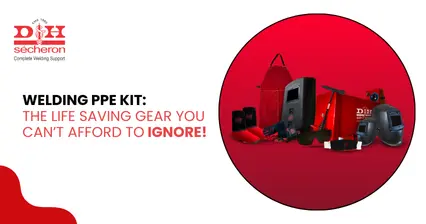Low Alloy Steel vs. High Alloy Steel: Understanding the Differences
Introduction
Alloy steel is a fascinating blend of iron and other elements that offers enhanced mechanical properties compared to plain carbon steel. There are two different types of alloy steels: low-alloy steel and high-alloy steel, based on the quantity and type of blend with iron metal. In this blog, we will understand the stark differences in these alloys and how D&H Sécheron plays a role in delivering quality steel.
A. Low-Alloy Steel
Low-alloy steel is a category of ferrous materials that exhibits mechanical properties superior to plain carbon steels due to the addition of specific alloying elements. These elements, such as nickel (Ni), chromium (Cr), molybdenum (Mo), and manganese, enhance specific properties of blending in quantities less than 5%.
Low alloy steels have high weldability, high melting point, and high ductility depending on the metals used to make the alloy. This resistance to heat and ductility makes them a great choice for steam boilers, pressure vessels, refinery crackers & reformers, and more!
B. High-Alloy Steel
High alloy steels contain more than 5% of alloying elements, like Stainless steel with 12% Chromium. Depending on their use and properties they are divided into 3 main types:
Martensitic: Hardens faster. (used in cutlery).
Ferritic: Conducting properties (automobile industry).
Austenitic: Corrosion resistance (corrosive environments like water tanks and pipes)
There are diverse applications of High-Alloy Steel across critical industries due to its exceptional properties. In high-temperature environments, heater tubes and boiler tubes made from high-alloy steels excel due to their corrosion resistance and ability to withstand extreme heat and pressure. Components in aircraft and heavy vehicles rely on high-alloy steel for critical parts, ensuring safety and longevity. In chemical and pharmaceutical equipment, high-alloy steel vessels and fittings resist chemical attack, safeguarding product purity and efficient operations.
Alloys can also be used as welding materials due to their resistance to corrosion, and erosion and their high strength to withstand impact. D&H Sécheron’s expertise in welding consumables ensures that these applications meet stringent requirements, contributing to reliable infrastructure and industrial processes. Their range of hard-facing wires, stainless steel, and low alloy electrodes play a crucial role in ensuring the longevity of the base materials used in equipment and machine parts.
Understanding the difference between low-alloy steels and high-alloy steels opens a new way to look at their applications in different sectors. Keeping in mind these needs, we at D&H Sécheron continually innovate the composition of their welding materials, like welding electrodes and welding wires. We bring to you a range of welding essentials that withstand the test of time. This makes us the leading welding manufacturers in India.
13 May 2025 | Welding
An In-Depth Exploration of Low-Alloy Steel: Your Comprehensive Guide
13 May 2025 | Welding
Nagpur - Bori - Tuljapur Road MSH-3 in Yavatmal District (Maharashtra)
13 May 2025 | Welding
Guidelines to Understand Gas Welding: Applications, Advantages & Disadvantages
13 May 2025 | Welding
3 Tips for Finding the Best Mild Steel Electrode for Your Application
13 May 2025 | Welding
How to Select the Right Welding Filler Wires for Stainless Steel Welding?
13 May 2025 | Welding
Building the Narendra Modi Stadium with Norma V and Autotherme-1 Electrodes
13 May 2025 | Welding
Low Alloy Steel Welding in a (PEB) Pre Engineered Building Structure
13 May 2025 | Welding
Welding Rods: Different Types and Tips for Properly Storing and Handling
13 May 2025 | Welding
Tips for Flawless Welds with Stainless Steel Electrodes: Pros and Cons
13 May 2025 | Welding
Exploring Applications and Benefits of Stainless Steel Welding Electrodes
13 May 2025 | Welding
Welding Basics: Joining Metals with Heat and Pressure - A Beginners Guide
13 May 2025 | Welding
Distinguishing Low-Alloy Steel from High-Alloy Steel: Understanding the Variations
13 May 2025 | Welding
Hard Facing Wire - Understanding the Process and Achieving Optimal Result
13 May 2025 | Welding
Exploring the Advantages of Stainless Steel Electrodes in Welding Applications
13 May 2025 | Welding
Weathering Steel vs. Traditional Steel: A Comparative Analysis of Performance
13 May 2025 | Welding
Choosing the Right Welding Rod: Why 6013 Electrodes Might Be Your Ideal Option
13 May 2025 | Welding
Why 7018 Electrodes Are Preferred for High-Strength Welds in Pipeline Construction
13 May 2025 | Welding
Filler Wire vs. Stainless Steel Filler Wire: Understanding the Key Differences
13 May 2025 | Welding
Exploring the Impact of Filler Material on Welding Quality and Durability
13 May 2025 | Welding
Choosing the Right Cast Iron Electrode for Different Welding Projects
13 May 2025 | Welding
Top Advantages of Cast Iron Electrodes for Industrial Welding Applications
13 May 2025 | Welding
Key Benefits and Challenges of Using TIG Welding in Industrial Projects
13 May 2025 | Welding
5 Reasons Why 7018 Electrode is the Gold Standard for Welding Professionals
13 May 2025 | Welding
Top 5 Advantages of Flux Cored Arc Welding for Heavy-Duty Applications.png)
13 May 2025 | Welding
Lotherme-601: A Game-Changer for Restoring Shoulder Pins in Heavy Machinery
13 May 2025 | Welding
How D&H Sécheron Helped Repair a Rotary Kiln’s Cooler Section with LoTherme 352
13 May 2025 | Welding
Piston Repair for Mining Industry: Cost-Effective Solutions with LoTherme 468.webp)






.jpg)








































.jpg)
.jpg)

.jpg)

.jpg)





.jpg)
.jpg)
.jpg)



.webp)
.jpg)
.jpg)
.webp)
.jpg)





















.png)



.webp)

.webp)
.webp)



